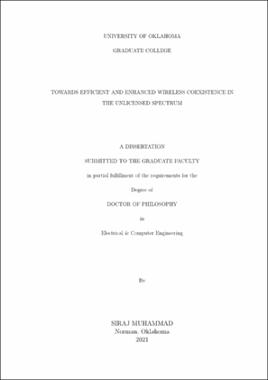| dc.description.abstract | The 3rd Generation Partnership Project (3GPP) is developing the fifth generation (5G) of wireless broadband technology and has identified the unlicensed spectrum as a principal item on the plan of action. Listen-Before-Talk (LBT) has been recognized as the starting development point for the channel access scheme of future 5G New Radio-Unlicensed (NR-U) networks. Recent technical reports suggest that all sub-7 GHz unlicensed spectrum is targeted for 5G NR-U operation, including the 2.4 GHz Industrial, Scientific, and Medical (ISM) band. Literature is inundated with research on Wi-Fi and LBT-based long-term evolution License-Assisted Access (LTE-LAA) wireless coexistence analysis. While a treasure trove of radio spectrum has been approved for license-exempt use in the 6 GHz band, industry and standard organizations must make sure it is well utilized by enhancing their coexistence schemes. A proper assessment of the homogeneous LBT deployment is imperative under the new use cases and regulatory circumstances. The work presented herein aimed to fill the gap and underline the importance of improving channel access mechanisms in next-generation wireless systems.
The research in this dissertation first analyzed the LBT channel access scheme and analytically evaluated its performance in terms of a metrics set, such as effective channel utilization, collision probability, mean access delay, and temporal fairness among coexisting nodes. Outcomes of the developed analytical model revealed inefficiencies in various cases. For example, high priority classes generally hinder overall effective channel utilization, exhibit a high collision rate, and incur long latencies compared to lower priorities; and low priority classes sustain longer delays in class-heterogeneous scenarios. The developed framework was then utilized to investigate wireless coexistence in a 5G-enabled intensive care unit, employing remote patient monitoring over 5G NR-U.
A modified LBT scheme is then proposed in this work to enhance overall channel efficiency in homogeneous LBT deployments by reducing the collision probability among coexisting stations based on the analytical investigation of the LBT mechanism.
It is expected that low-power, narrowband frequency hoppers will be allowed to operate in the 6 GHz spectrum based on recent European Communications Committee (ECC) mandates, which raises speculation around coexistence with incumbent radio access technologies (RATs). To address the potential operation of cellular LBT in the 2.4 GHz and frequency hopping systems in the 5- and 6-GHz bands, the coexistence of Bluetooth Low Energy (BLE) 5 and LBT was investigated empirically in an anechoic chamber. The mutual impact was explored by means of throughput, packet error rate, and interframe delays. Empirical evaluation results demonstrated how BLE throughput dropped as the intended-to-unintended signal ratio decreased and the way in which LBT classes exhibited a diminishing effect as the class priority descended. Long Range BLE physical layer (PHY) was found to sustain longer gap times (i.e., delay) than the other two PHYs; however, the LR PHY showed less susceptibility to interference. Results also demonstrated that low data rate BLE PHYs hindered LBT throughput performance since they correspond to longer airtime durations. | en_US |
